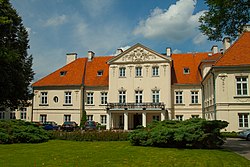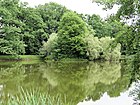Leszno, Warsaw West County
Leszno | |
|---|---|
Village | |
 Łuszczewski Palace in Leszno | |
| Coordinates: 52°16′N 20°36′E / 52.267°N 20.600°E | |
| Country | |
| Voivodeship | Masovian |
| County | Warsaw West |
| Gmina | Leszno |
| Population | |
• Total | 3,500 |
| Time zone | UTC+1 (CET) |
| • Summer (DST) | UTC+2 (CEST) |
| Postal code | 05-084[1] |
| Vehicle registration | WZ |
| Primary airport | Warsaw Chopin Airport |
| Website | http://www.gminaleszno.pl/ |
Leszno [ˈlɛʂnɔ] is a village in Warsaw West County, Masovian Voivodeship, in east-central Poland. It is the seat of the gmina (administrative district) called Gmina Leszno.[2] It lies approximately 15 kilometres (9 mi) west of Ożarów Mazowiecki and 28 km (17 mi) west of Warsaw.
Polish professional footballer Robert Lewandowski grew up in Leszno.[3] In 2016 he became an honorary citizen of Leszno.[3]
History
[edit]The history of Leszno dates back to the Middle Ages. It was mentioned in documents in 1423.[4] It was owned by various families, including the Łuszczewski family, which built a Baroque palace, which is the main landmark of the village.[4]
In the mid-19th century, a sugar factory was established in the village, the first in Poland equipped with a steam turbine.[5]
Several men from Leszno died in various battles against the invading Russians during the Polish–Soviet War of 1919–1920.[6] A memorial to those soldiers is located in the local Catholic Church of Saint John the Baptist.[6]
During the invasion of Poland, which started World War II, in early September 1939, the Germans captured Leszno.[7] On September 16, Poles recaptured the village for tactical purposes, while the Germans retreated in panic.[7] On September 17, the Germans occupied Leszno again, and carried out a massacre of around 50 inhabitants in an act of revenge.[8] Many men were transported to Błonie, from where they were to be deported to forced labor to Germany, but some managed to escape.[7] About 70% of the village was burned down.[7]
Sights
[edit]The main landmark of Leszno is the Baroque Łuszczewski Palace with an adjacent park. There are two historic churches, one Catholic and one Mariavite. In the village there is also a monument commemorating Polish soldiers, partisans and inhabitants killed during World War II.[4]
Sports
[edit]The local football club is Partyzant Leszno. Robert Lewandowski took his first steps in football in the club. It competes in the lower leagues.
Gallery
[edit]-
Architectural decorations on the facade of the Łuszczewski Palace
-
Park
-
Saint John the Baptist church
-
Gmina office
References
[edit]- ^ "Oficjalny Spis Pocztowych Numerów Adresowych" (PDF). Poczta Polska (in Polish). Archived (PDF) from the original on 22 February 2014. Retrieved 31 January 2025.
- ^ "Central Statistical Office (GUS) - TERYT (National Register of Territorial Land Apportionment Journal)" (in Polish). 2008-06-01.
- ^ a b "Robert Lewandowski honorowym obywatelem Leszna". ZachodnieMazowsze.info (in Polish). Retrieved 8 May 2020.
- ^ a b c "Wieś Leszno". Szlaki turystyczne Mazowsza (in Polish). Retrieved 8 May 2020.
- ^ Modzelewski, Rafał; Jarosz, Monika. Industrialne Mazowsze (in Polish). Warszawa: Mazowiecka Regionalna Organizacja Turystyczna. p. 34. ISBN 978-83-8218-191-3.
- ^ a b Kowalski, Andrzej (1995). "Miejsca pamięci związane z Bitwą Warszawską 1920 r.". Niepodległość i Pamięć (in Polish) (2/2 (3)). Muzeum Niepodległości w Warszawie: 139. ISSN 1427-1443.
- ^ a b c d "79. rocznica spalenia Leszna". Stowarzyszenie Aktywne Leszno (in Polish). Retrieved 8 May 2020.
- ^ Wardzyńska, Maria (2009). Był rok 1939. Operacja niemieckiej policji bezpieczeństwa w Polsce. Intelligenzaktion (in Polish). Warsaw: IPN. p. 97.







